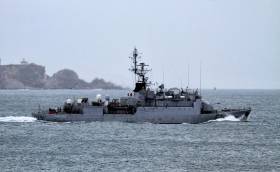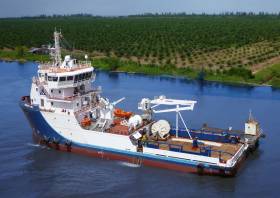Displaying items by tag: Cork City Quays
Start of Petition In Favour of High-Rise Buildings in Cork
A former Fine Gael candidate Julie O’Leary has started a petition in favour of high-rise, high-density development in the docklands.
The petition, reports EchoLive, was signed by close to 400 people in its first few hours online, comes after a flurry of planning applications for tower complexes in the docklands area.
Though the scale and design of the planned towers have been controversial, Ms O’Leary said that developments like these are key for Cork to grow.
“The key to unlocking Cork’s potential is building high density and high rise development in and near the city centre,” she said.
For further reading on this development click here.
Dutch Stealth Submarine Heads Upriver to Dock In Cork City-Centre
#NavyVisits - HNLMS Walrus which is one of the world's most sophisticated submarines arrived in Cork City yesterday for a courtesy visit this weekend, writes Jehan Ashmore.
The non-nuclear powered submarine is the leadship of the 'Walrus' class which was commissioned in 1992 for the Royal Netherlands Navy. In total there are four of the class and they are the only submarines of the Dutch Navy but play a pivotal role in operations.
HNLMS Walrus entered Cork Harbour in the afternoon. From within the expanse of the lower harbour, the 68m submarine navigated further upriver through Lough Mahon before making the final leg to the city's central quays.
According to the Dutch Embassy the visit to Cork is for the purpose of crew rest. Embarkation of the 50 submariners is from J.J. Horgan's Wharf on the north bank of the River Lee.
On this occasion, the Dutch Navy will not be on training exercises as previously conducted by a pait of fleetmates, albeit surface ships that visited Dublin last month. This involved a Landing Platform Dock (LPD) amphibious warfare ship and a frigate that took part in exercises off the east coast with the Irish Naval Service OPV L.É. William Butler Yeats.
The diesel-electric powered HNLMS Walrus has 4 torpedo tubes incorporated within the stealth designed submarine. Such technology is to make it more difficult to be detected by ships, aircraft or other submarines when deep under the ocean waves.
At 2,650 tonnes displacement (when submerged) HNLMS Walrus can remain under the water surface for long periods to enable missions. On overseas deployments, this can include patrolls in the Caribbean Sea with calls to Williamstad, the capital of Netherlands Antilles.
On this side of the Atlantic, the berth allocated in Cork for the submarine's visit as alluded above is where a sister HNLMS Dolfijn paid a call in 2016. That submarine did take part in exercises witht the Naval Service.
HNLMS Walrus will remain in port until Monday morning.
Winter Visitor From France Makes Call to Cork City Quays
#navalvisits - A French Navy frigate docked in Cork city at the weekend having sailed from Cherbourg, Normandy though the ship is based at Brest Naval Base in neighbouring Brittany, writes Jehan Ashmore.
The 1,250 tonnes full displacement Commandant L'Herminier (F 791) according to the Port of Cork website remains berthed this morning at the city-centre’s South Quays. A crew compliment totalling almost 90 personnel consists of 7 senior officer ranks, 58 secondary officer mariners and 24 cadets.
Commandant L'Herminier is an Aviso type A69 / d'Estienne d'Orves ship that was commissioned into the French Navy having made a debut more than three decades in 1986. The 80m long class vessel designed for anti-submarine duties also carries out high sea escort missions and various other tasks.
Among the principle weaponary of the class are Exocet sea missiles and the ability to launch torpedoes. In addition equipment such as a drone that form part of a suite of surveillance operations.
A maximum 15 day duration period is available when operating in an autonomous mode. The ship's service speed is 24 knots.
Second Seismic Ship Makes Maiden Irish Port of Call to Owners 'Mainport' Homeport
#CorkHarbour - An unusually high concentration of Mainport Group vessels among them a seismic-survey ship made a maiden Irish port of call to her owners homeport of Cork Harbour this morning, writes Jehan Ashmore.
Afloat had monitored the arrival of Mainport Pine, the most modern of the Cork based company fleet that docked just before 09.30hrs. Mainport Pine of 1,659 gross tonnage was delivered in 2014 and is the second of a pair of commissioned Malaysian built seismic-survey vessels.
These high-tech sophisticated vessels collect information about the subsea and so are vital for the oil and gas industry. The pair are used on the charter market by the exploration /energy companies.
Almost a year ago Afloat reported on sister Mainport Cedar completed in 2013, had previously also made a homecoming debut to Cork. At the time the vessel was undergoing maintenance in between a repositioning voyage that led to a contract for the oil industry based in the Gulf of Mexico.
Mainport Pine had departed Bergen, Norway and Afloat yesterday had also tracked the ship while offshore of Wicklow Head when bound for Cork. It was at the city's central quays that this morning saw the ship berth astern of a fleetmate, Mainport Kells. This seismic-chase vessel is designed to intercept any approaching vessels which could damage cables being towed or installed on the seabed.
The pair are togther berthed at North Custom House Quay.
Downriver one of Mainport's tugs Celtic Isle which in recent years was transferred from Shannon Estuary operations at the Port of Foynes, is berthed at Cork Dockyard.
Asides towage duties, Celtic Isle is employed on serving the requirements of the Kinsale Gas Field along with Ocean Spey which was acquired last year. This standby and supply vessel with handling handling capacity is this morning offshore of the two gas platforms rigs in the Celtic Sea.
University Challenge Heads for Cork
#NAVAL VISITS – Two small University Royal Naval Units (URNU) patrol training boats of the Royal Navy are due to call to Cork city centre along South Customs House Quay this afternoon, writes Jehan Ashmore.
The pair are HMS Exploit (P167) and HMS Express (P163) and they belong to a 14-strong P2000 Archer Fast Inshore Patrol Class. They form the First Patrol Boat Squadron and their primary role is to support the URNU but they also contribute to a wide range of fleet tasking.
Each vessel displaces 54 tonnes and has a crew of five on a boat that is just over 20m and draws a draft nearing 2m. Top speed is 22 knots and they can cover a range of 550 nautical miles.
HMS Exploit is the Birmingham University Royal Navy Unit's Training Patrol vessel, although the unit covers a wide area, taking undergraduates from eight Universities in the region. She was built by Vosper Thornycroft and commissioned in 1988. The boat is berthed in Penarth Marina, near Cardiff.
Likewise HMS Express is based at Penarth, she too provides sea training and offers an insight into the modern Royal Navy for Wales URNU undergraduates drawn from Cardiff, Swansea and Glamorgan Universities and University of Wales Institute Cardiff. Last year she took part in the Three Peaks Challenge.
The patrol boats follow last month's call also to the city of the Marine Protection Vessel (MPV) Jura which at 84m long makes her the largest of the three-strong Marine Compliance Scotland fleet. On that occasion she docked opposite at the North Customs House Quay.
Countdown to Cork Harbour Open Day
This will be the third Cork Harbour Day which is to cover a wide range of events, such as concerts on Spike Island, a photographic exhibition in Camden Fort, guided tours of an Irish naval ship at Cork City Quays and an open day at the National Maritime College of Ireland (NMCI).
In addition Fastnet Line's ferry Julia will be open for the public to board. The 22,161 gross tonnes serves the Cork-Swansea route and for the Open Day she will be berthed at Ringaskiddy Deepwater Berth instead of the nearby ferry terminal. To read details of Open day programme visit www.corkharbour.ie and updates click HERE.
The concept for the Harbour Open Day emerged three years ago, which combined various stakeholders involved in the development and implementation of the Integrated Strategy for Cork Harbour. A group comprising of representatives from UCC, City and County Councils, the Naval Service and the Port of Cork set about working together to engage with users of the harbour and to organise the Open Day.
Cork Harbour is the second largest natural harbour in the world, next to Sydney Harbour, offering beautiful locations for enjoying the outdoors, dramatic coastlines, and excellent leisure facilities, and is home to some very talented artists, sportsmen and women, and people who are passionate about the history, heritage and cultural value of Cork Harbour.
- Spike Island
- Cobh
- Cork Harbour
- naval service
- National Maritime College of Ireland
- port of Cork
- Cruise Liners
- Cork Harbour Open Day
- NMCI
- Ports and Shipping
- Cobh Cruise Terminal
- Cork Harbour News
- Cunard Line
- Queen Elizabeth
- Cruise ships
- Cork City Quays
- Camden Fort
- Port of Cork Company
- Ringaskiddy Deepwater Terminal
Naval Salvage Tug Docks in Cork City
Built by Schichau Seebeck Werft, Bremerhaven, the 68m vessel has a limited armament capability and a crew of 45. Her main role is as a safety ship for use in submarine training and is equipped for fire-fighting, icebreaking and wreck location duties.
The veteran vessel had called to Dublin Port last weekend while her stay in the southern city will end with a departure scheduled for Monday morning.


































































